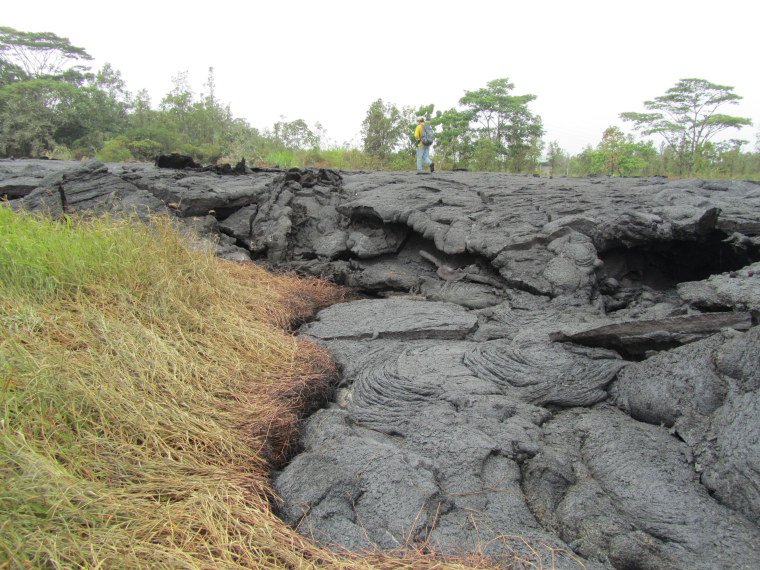When a mountain of molten rock clocking in at 2,000 degrees is headed your way, there's only one thing you can do — leave. And with the latest lava flow from Hawaii's Kilauea volcano now less than the length of a football field away from homes, that's just what the residents of the small community of Pahoa are doing.
How long has this been going on?
The stream of red-hot rock has been creeping toward Pahoa and the surrounding rural region of Puna for four months, since a vent in the Pu'u O'o crater on Kilauea's eastern rift again began spewing smoke and lava on June 27 — something the world's youngest and most active volcano has been doing off and on in a continuous eruption since 1983.
Since then, residents, geologists and civil defense officials have been watching and waiting, trying to figure out what path the lava would take. Saturday, the 150-yard-wide flow began washing over Pahoa cemetery — leaving blackened tombstones standing starkly over the new rock landscape.
What are the dangers?
The threat from the lava may seem similar to that from the mudslide that killed 43 people as it engulfed the town of Oso in Washington in March. In fact, the lava itself is the least of residents' concerns. There's nothing they can do about it, and they've had plenty of time to prepare.
Instead, the lava bears hidden hazards:
- Supplies: Hawaii County Civil Defense officials closed Pahoa Village Road on Sunday night not far from state Highway 130, the main road into and out of town. Pahoa is the commercial center of the Puna region, home to most of its groceries, gas stations and medical services — if Pahoa is closed or deserted, residents face a 100-mile drive to the closest vital goods and health care, The Weather Channel reported Monday.
"This is a difficult situation for the people of Puna, it really is," Stephanie Bath, manager of the Red Cross shelter that has been set up at a nearby church, told NBC station KHNL of Honolulu. "The people are losing everything that they have."
- Poisonous smoke and gases: So far, smoke released as the lava burns up vegetation has remained light to moderate as prevailing winds have pushed it away from populated areas. But that could change at any time, threatening people with respiratory problems. At the same they're being urged to evacuate, they're also being told to stay indoors.
Meanwhile, "gas emissions remained elevated," the U.S. Geological Survey's Hawaii Volcano Observatory said, at 2,700 to 3,600 metric tons, or 6 million to 8 million pounds, per day. The gases — mainly sulfur compounds like sulfur dioxide — form poisonous acids when they react with water, and potentially lethal gas levels could reach as far as three-quarters of a mile downwind, it said.
- Power: Electric poles in Hawaii's volcano zones are wrapped in heat-resistant materials, but they'll still probably eventually burn. Hawaii Electric Light said it has moved a large diesel generator to the region to provide an alternative source of power in case "the existing power distribution lines become inoperable" and the area is cut off from the main power grid.
"The long-term results are still not determined," said Rhea Lee, a spokeswoman for the utility. "As the lava flow progresses, we expect the lava will rise and inflate."
How are residents coping?
Hawaii civil defense workers were going door to door in and around the town on the Big Island on Monday, urging residents in the immediate path of the lava to evacuate. They said about 95 percent of the people they'd reached had some place else to go, while the rest were heading for a Red Cross shelter.
The lava flow was only about 70 yards from the closest occupied home Monday night, and it was moving about 20 yards per hour, Hawaii County emergency management officials said. The couple who live in that home have already packed up and left, they said.
Alii Hauanio's family lost their beach home in the 1990-91 Kilauea lava flow that destroyed the town of Kalapana. Now, his home in Pahoa is similarly threatened.
"I never thought it would be this way," Hauanio told KHNL.
Hauanio has already started packing — mostly his parents' memorabilia, he told the station.
"You know, honestly, it's just material. I came into this world naked. I'm going out naked," he said. "The memories I can take. And that's what’s the most precious, and that's what I can keep."
